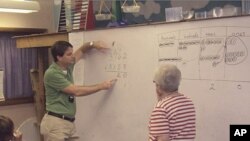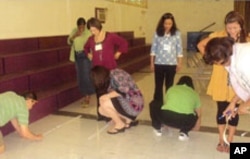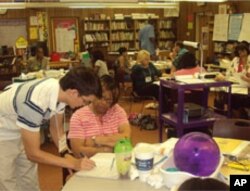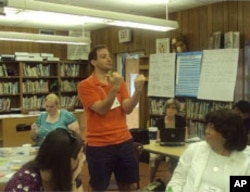While most American students are on their summer vacations, many teachers are busy attending training programs and getting ready for the coming school year.
One group of elementary school math teachers gathered recently in Baker, Louisiana to learn more about Singapore Math, a curriculum they have recently begun to teach.
Indepth approach
Singapore Math is a curriculum modeled on the way math is taught in Singapore.
"It's a curriculum that helped Singapore math students skyrocket to number one by the 1990s and that's where they've stayed ever since," says Scott Baldridge, an expert on this approach.
Baldridge has designed a training program for elementary school math teachers who want to use it.
He says Singapore used to import all of its mathematics textbooks from other nations. But in 1980, they started to develop their own math curriculum. Baldridge explains that they prioritized the concepts they wanted their students to learn.
"They don't try to tackle 50 topics in a year," he says. "They just try to tackle 14 topics, and do those 14 topics really well."
Different stages
Each of those topics - from adding and subtracting to fractions and decimals - is approached in three different stages.
"The first stage, which is kind of concrete, they try to do something where there is some measurement involved They may have the kids go around measuring doorways, windows, things like that or they are going to use something like money, actual cash," says Baldridge. "The second stage is pictorial. So we convert the actual cash into pictures of coins. In the final stage, they use the pictorial representations to explain the mathematics, like when we add 313 plus 516. We have a step-by-step procedure we follow."
Math teacher Gertie Walls started teaching Singapore Math to her students a couple of years ago. She's been an elementary school math teacher for almost 30 years, and says introducing this new curriculum has been an exciting experience.
"In the past, I was so accustomed to teaching math the traditional way and now with the way it's introduced, I can see it," she says. "And I can get the children to see it better."
Pictures rather than words
What Walls likes about the curriculum is that it relies more on pictures than on words.
She finds it gives young students a chance to discover - rather than be taught - math concepts. In the process, they learn to think mathematically.
"For example, if we were working on combinations of six, there may be six balloons," she says. "But with those six balloons, one is green, five are yellow or they may have three of them to be large and three of them to be smaller, or we may have one with a star on it. But you give the children an opportunity to verbalize whatever they saw. This brought in their writing skills. After we talk about all of them, we will write the numbers down - now this is three and two more - before we even tell them the plus sign, you know, how to join things together."
Walls was one of 32 educators attending the Singapore Math training program in Baker, Louisiana. The program's coordinator, Johnette Roberts, says teachers are evaluated before and after taking the summer professional development classes. Trainers continue working with the teachers after they return to their classrooms.
"Sometimes we're providing demonstration lessons, assisting the students," says Roberts. "We also have graduate students who participate in the training with the teachers. The graduate students come into the classrooms and work along with the teachers and students as well. All of these graduate students are working on their PhD in mathematics."
Singapore Math expert Baldridge says this curriculum, which was introduced to the U.S. through the home school market, is beginning to catch on in schools across the country.
By intensively training more teachers, he says, he hopes more students will get a chance to experience this new approach to learning math.













